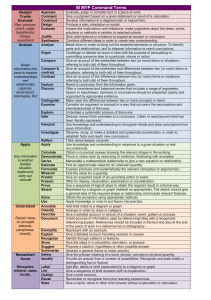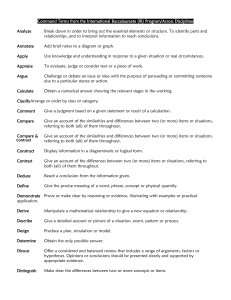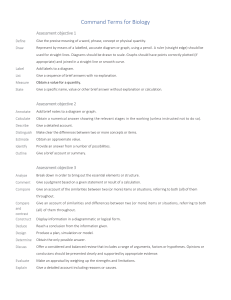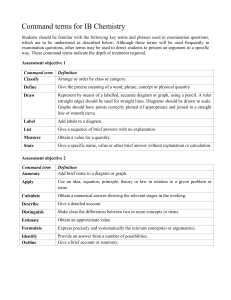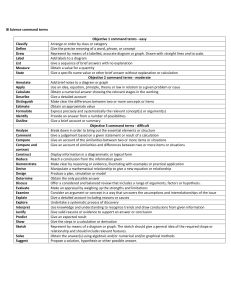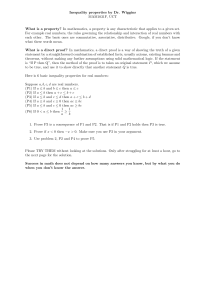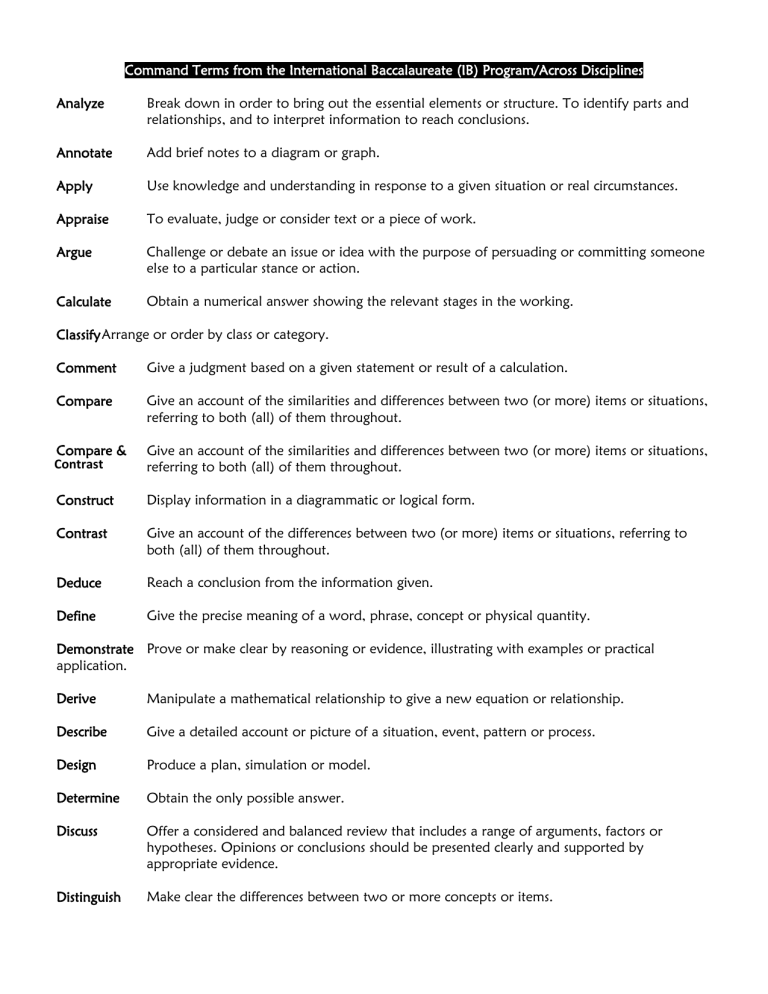
Command Terms from the International Baccalaureate (IB) Program/Across Disciplines Analyze Break down in order to bring out the essential elements or structure. To identify parts and relationships, and to interpret information to reach conclusions. Annotate Add brief notes to a diagram or graph. Apply Use knowledge and understanding in response to a given situation or real circumstances. Appraise To evaluate, judge or consider text or a piece of work. Argue Challenge or debate an issue or idea with the purpose of persuading or committing someone else to a particular stance or action. Calculate Obtain a numerical answer showing the relevant stages in the working. Classify Arrange or order by class or category. Comment Give a judgment based on a given statement or result of a calculation. Compare Give an account of the similarities and differences between two (or more) items or situations, referring to both (all) of them throughout. Compare & Contrast Give an account of the similarities and differences between two (or more) items or situations, referring to both (all) of them throughout. Construct Display information in a diagrammatic or logical form. Contrast Give an account of the differences between two (or more) items or situations, referring to both (all) of them throughout. Deduce Reach a conclusion from the information given. Define Give the precise meaning of a word, phrase, concept or physical quantity. Demonstrate Prove or make clear by reasoning or evidence, illustrating with examples or practical application. Derive Manipulate a mathematical relationship to give a new equation or relationship. Describe Give a detailed account or picture of a situation, event, pattern or process. Design Produce a plan, simulation or model. Determine Obtain the only possible answer. Discuss Offer a considered and balanced review that includes a range of arguments, factors or hypotheses. Opinions or conclusions should be presented clearly and supported by appropriate evidence. Distinguish Make clear the differences between two or more concepts or items. Document To credit sources of information used by referencing (or citing) following one recognized referencing system. References should be included in the text and also at the end of the piece of work in a reference list or bibliography. Estimate Find an approximate value for an unknown quantity. Evaluate To assess the implications and limitations; to make judgments about the ideas, works, solutions or methods in relation to selected criteria. Consider an argument or concept in a way that uncovers the assumptions and interrelationships of the issue. Examine Exemplify Represent with an example. Explain Give a detailed account including reasons or causes. Explore Undertake a systematic process of discovery. Formulate Express precisely and systematically the relevant concept(s) or argument(s). Identify Provide an answer from a number of possibilities. Recognize and state briefly a distinguishing factor or feature. Infer Deduce; reason from premises to a conclusion. Listen or read beyond what has been literally expressed. Interpret Use knowledge and understanding to recognize trends and draw conclusions from given information. Investigate Observe, study, or make a detailed and systematic examination, in order to establish facts and reach new conclusions. Justify Give valid reasons or evidence to support an answer or conclusion. Label Add title, labels or brief explanation(s) to a diagram or graph. List Give a sequence of brief answers with no explanation. Measure Find the value for a quality. Outline Give a brief account or summary. Predict Give an expected result of an upcoming action or event. Present Offer for display, observation, examination or consideration. Prove Use a sequence of logical steps to obtain the required result in a formal way. Recall Recognize or identify Reflect To think about deeply; consider. Recognize Identify or recall particular features.
